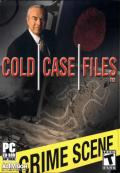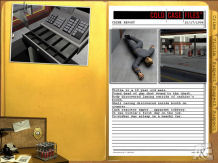Cold Case Files is based on
the television series of the same title. Although I don’t follow this
series on TV, I quickly determined that “cold” cases are murder cases that
have never been solved.
This is a first person point-and-click adventure game in which you
assume the role of a particularly determined detective who has the latest
technology at his fingertips. You go back through forgotten case files to
solve murders that are months, even years old -- crimes where the
cleverness of the perpetrator, a lack of thorough investigative procedure,
or the inability to use the latest forensic technology has allowed a
criminal to go free.
The game is made up of six cases, and each takes less than an hour to
solve. (A downloadable bonus case was available, but the webpage now
appears to be inaccessible.) You can solve the cases in any order – all
are available in the Main Menu. Each case opens with a cutscene, where
the crime is briefly and effectively described. From there you are taken
to the office of the Chief Investigator who discloses additional details.
Interface icons then appear on the lower left of the screen. These give
you access to text messages and also take you to your office, to the crime
lab, and back to the Chief’s office.
Evidence Speaks When Victims Can’t
As you look around your office, you’ll find a desk, a bulletin board,
and a door to the Evidence Room with boxes of stuff to sift through. The
bulletin board serves as your portal to the scene of the crime and to
locations where you can interview witnesses. In front of you on the desk
is the case file – this fills up with information as the investigation
proceeds.
Gameplay consists of searching the locations, interviewing the
witnesses and suspects, clicking on anything active in the lab (computer
or microscope), checking out the boxes of evidence in the Evidence Room,
chatting with the Chief, and examining everything in the files. If you do
all of this (one case requires one other step, but I won’t spoil that for
you), you will be able to arrest the perpetrator.
The stories in Cold Case Files do have potential and they piqued
my interest. It was fun to compare the viewpoints of various witnesses
and to figure out how the evidence exonerated or discredited the
suspects. Admittedly there is not a great deal of realism in certain of
the details. For instance, you find it laughably easy to find evidence
from crimes that occurred years earlier. (Apparently, no one ever sweeps
floors or picks up litter in this world.)
The Park is More Confining Than the Big House
Environments are photorealistic, fairly detailed and static. They
feature muted colors and realistic shadows and reflections. Some have a
gritty, even sordid quality – you’ll see rust, peeling paint, stained
carpets. Most of the environments are just backdrops. You cannot move or
turn around to examine your surroundings. When searching for physical
clues, there is some limited ability to move about the crime
scene. Searchable areas generally involve three to five screens.
Compared to other adventure games, the environments feel quite
restrictive.
If They Blink, You Might Miss Something
Character models are realistically drawn, but stiff. The different
characters make different repetitive, characteristic movements as they
speak to you. Curiously, many of them refuse to look you in the eye.
Their mouths move as they talk (no lip sync) but otherwise facial movement
is nonexistent. After awhile, I felt as though I was caught up in a
twilight zone where eye contact or spontaneous movement is rigorously
discouraged.
That said, some of the voice acting is rather good – good enough that
it makes the character models look even stranger. Do you expect lively
inflection and expressive speech from someone who is rocking back and
forth while gazing fixedly at the floor?
While some of the characters in the game are less than intriguing, one
breaks the mold – the lab technician. This character (I have no idea what
her name is) has a gorgeous face, a sensual mouth and a figure that (even
under the lab coat) is obviously voluptuous. She also has purple hair and
nerdy black glasses. Frustratingly, when you deliver something for her to
analyze, you must leave the lab in order to get the results. Standing
there and staring at her does not allow the game to progress.
So you drop off the item to be analyzed, then you leave. You receive a
message almost instantly that the lab results are in. You return to the
lab, the lab technician turns her head abruptly to look at you. You try
to stop gawking at her, and she gives you the good (or bad) results. Her
mouth moves, her expression is deadpan. You wonder what she does for fun
after a hard day at the lab. She looks away. End of interaction.
Bongo Beats
The music in Cold Case Files is unexpected. It exploits odd
instruments and rhythms and strives to set you slightly on edge. In that
it is effective, although it does tend to become repetitive.
There aren’t a lot of ambient sounds in this game world. The most
memorable are the “bongo” noises when you click on the icons on the lower
left and the chirpy computer noises when you use the machine in the lab.
Doors sometimes make a noise when they close and there were sounds of
billiards being played in the Lucky Duff’s Pub.
Glitch-Free Gaming
The game uses an autosave system. If you beat a case, the game credits
you with the “win.” If you exit the game while in a middle of a case
without arresting the right suspect, you are back at square one with that
particular case when you play the game again. If you decide to arrest a
suspect, but don’t have sufficient evidence to convict, you are told that
you have failed. If you elect to continue playing after the “failure,”
you are placed back in the game without losing your progress, so you can
gather more evidence.
Cold Case Files was stable, installed with ease and contained no
glitches. The entire game is copied to the hard drive – after
installation, you don’t need the CD to play the game. Subtitles can be
enabled in the Options menu.
Is Casual A Good Thing?
Although just about every adventure game I’ve ever played contained
more complexity, more challenge and more environmental immersion than
Cold Case Files, the game does work unexpectedly well as a “casual”
game. There are two reasons for this.
First – the game is relaxing. It isn’t addictive or compelling, but
the stories in Cold Case Files are reasonably entertaining.
The format works well for those times when I feel like winding down and
enjoying a quick story after finishing a difficult session in a more
challenging game. If the purpose of games like this one is to address the
“casual gaming” market, I don’t think it makes sense to encumber them with
difficult or complex puzzles. Casual adventure games ought to be on the
easy side, and Cold Case Files definitely is.
Second – because the cases in this game are discrete and short, I could
play one, and return days or weeks later to play another. Most adventure
games have a background story arc that has to be understood in order to
fully appreciate the game. If you are playing a “hardcore” adventure and
return to it after days of not playing, there is always a period in
which you must reorient and reintroduce yourself to the story and the game
world. With Cold Case Files, reorientation isn’t necessary – a
characteristic that is just right in a game aimed at casual gamers.
I found the self-contained short story format exemplified by Cold
Case Files to be an attractive innovation, even though it wasn’t
satisfactorily realized here. I would like to see the format used again,
though with better character development and animation, as well as larger
environments that allow more freedom of movement.
Quick List for Cold Case Files
First person, point-and-click adventure that investigates six “cold”
cases in which the murderer has never been caught. The crime stories are
intriguing, though brief in scope. No difficult challenges of any kind –
no sliders, mazes, timed puzzles or sound puzzles. Gameplay can be
characterized as searching the various locations, reading files,
interviewing witnesses, and using the crime lab tools (computer and
microscope).
Environments are crisply delineated and authentic, but also stationary
and too confining. Character animation is uncommonly poor. The music is
unusual; the voice acting is competent to good. You cannot die in the
game.
No glitches or problems with installation. The game autosaves.
Cold Case Files is aimed at casual gamers who will enjoy a
chance to play interactive detective stories, and at fans of the Cold
Case Files television series.
Final Grade: C
2-2006
design copyright ©
2006
GameBoomers
Group

